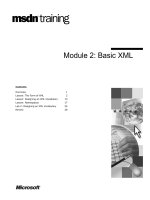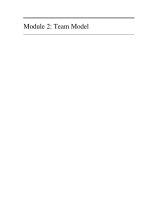Chapter 2 - Control Structures docx
Bạn đang xem bản rút gọn của tài liệu. Xem và tải ngay bản đầy đủ của tài liệu tại đây (889.84 KB, 89 trang )
2003 Prentice Hall, Inc. All rights reserved.
1
Chapter 2 - Control Structures
Outline
2.1 Introduction
2.2 Algorithms
2.3 Pseudocode
2.4 Control Structures
2.5 if Selection Structure
2.6 if/else Selection Structure
2.7 while Repetition Structure
2.8 Formulating Algorithms: Case Study 1 (Counter-Controlled
Repetition)
2.9 Formulating Algorithms with Top-Down, Stepwise Refinement:
Case Study 2 (Sentinel-Controlled Repetition)
2.10 Formulating Algorithms with Top-Down, Stepwise Refinement:
Case Study 3 (Nested Control Structures)
2.11 Assignment Operators
2.12 Increment and Decrement Operators
2.13 Essentials of Counter-Controlled Repetition
2.14 for Repetition Structure
2.15 Examples Using the for Structure
2003 Prentice Hall, Inc. All rights reserved.
2
Chapter 2 - Control Structures
Outline
2.16 switch Multiple-Selection Structure
2.17 do/while Repetition Structure
2.18 break and continue Statements
2.19 Logical Operators
2.20 Confusing Equality (==) and Assignment (=) Operators
2.21 Structured-Programming Summary
2003 Prentice Hall, Inc. All rights reserved.
3
2.1 Introduction
•
Before writing a program
–
Have a thorough understanding of problem
–
Carefully plan your approach for solving it
•
While writing a program
–
Know what “building blocks” are available
–
Use good programming principles
2003 Prentice Hall, Inc. All rights reserved.
4
2.2 Algorithms
•
Computing problems
–
Solved by executing a series of actions in a specific order
•
Algorithm a procedure determining
–
Actions to be executed
–
Order to be executed
–
Example: recipe
•
Program control
–
Specifies the order in which statements are executed
2003 Prentice Hall, Inc. All rights reserved.
5
2.3 Pseudocode
•
Pseudocode
–
Artificial, informal language used to develop algorithms
–
Similar to everyday English
•
Not executed on computers
–
Used to think out program before coding
•
Easy to convert into C++ program
–
Only executable statements
•
No need to declare variables
2003 Prentice Hall, Inc. All rights reserved.
6
2.4 Control Structures
•
Sequential execution
–
Statements executed in order
•
Transfer of control
–
Next statement executed not next one in sequence
•
3 control structures (Bohm and Jacopini)
–
Sequence structure
•
Programs executed sequentially by default
–
Selection structures
•
if, if/else, switch
–
Repetition structures
•
while, do/while, for
2003 Prentice Hall, Inc. All rights reserved.
7
2.4 Control Structures
•
C++ keywords
–
Cannot be used as identifiers or variable names
C++ Keywo rds
Keywords common to the
C and C++ programming
languages
auto
break
case
char
const
continue
default
do
double
else
enum
extern
float
for
goto
if
int
long
register
return
short
signed
sizeof
static
struct
switch
typedef
union
unsigned
void
volatile
while
C++ only keywords
asm
bool
catch
class
const_cast
delete
dynamic_cast
explicit
false
friend
inline
mutable
namespace
new
operator
private
protected
public
reinterpret_cast
static_cast
template
this
throw
true
try
typeid
typename
using
virtual
wchar_t
2003 Prentice Hall, Inc. All rights reserved.
8
2.4 Control Structures
•
Flowchart
–
Graphical representation of an algorithm
–
Special-purpose symbols connected by arrows (flowlines)
–
Rectangle symbol (action symbol)
•
Any type of action
–
Oval symbol
•
Beginning or end of a program, or a section of code (circles)
•
Single-entry/single-exit control structures
–
Connect exit point of one to entry point of the next
–
Control structure stacking
2003 Prentice Hall, Inc. All rights reserved.
9
2.4 Control Structures
2003 Prentice Hall, Inc. All rights reserved.
10
2.5 if Selection Structure
•
Selection structure
–
Choose among alternative courses of action
–
Pseudocode example:
If student’s grade is greater than or equal to 60
Print “Passed”
–
If the condition is true
•
Print statement executed, program continues to next statement
–
If the condition is false
•
Print statement ignored, program continues
–
Indenting makes programs easier to read
•
C++ ignores whitespace characters (tabs, spaces, etc.)
2003 Prentice Hall, Inc. All rights reserved.
11
2.5 if Selection Structure
•
Translation into C++
If student’s grade is greater than or equal to 60
Print “Passed”
if ( grade >= 60 )
cout << "Passed";
•
Diamond symbol (decision symbol)
–
Indicates decision is to be made
–
Contains an expression that can be true or false
•
Test condition, follow path
•
if structure
–
Single-entry/single-exit
2003 Prentice Hall, Inc. All rights reserved.
12
2.5 if Selection Structure
•
Flowchart of pseudocode statement
A decision can be made on
any expression.
zero - false
nonzero - true
Example:
3 - 4 is true
2003 Prentice Hall, Inc. All rights reserved.
13
2.6 if/else Selection Structure
•
if
–
Performs action if condition true
•
if/else
–
Different actions if conditions true or false
•
Pseudocode
if student’s grade is greater than or equal to 60
print “Passed”
else
print “Failed”
•
C++ code
if ( grade >= 60 )
cout << "Passed";
else
cout << "Failed";
2003 Prentice Hall, Inc. All rights reserved.
14
2.6 if/else Selection Structure
•
Ternary conditional operator (?:)
–
Three arguments (condition, value if true, value if false)
•
Code could be written:
cout << ( grade >= 60 ? “Passed” : “Failed” );
Condition Value if true Value if false
2003 Prentice Hall, Inc. All rights reserved.
15
2.6 if/else Selection Structure
2003 Prentice Hall, Inc. All rights reserved.
16
2.6 if/else Selection Structure
•
Nested if/else structures
–
One inside another, test for multiple cases
–
Once condition met, other statements skipped
if student’s grade is greater than or equal to 90
Print “A”
else
if student’s grade is greater than or equal to 80
Print “B”
else
if student’s grade is greater than or equal to 70
Print “C”
else
if student’s grade is greater than or equal to 60
Print “D”
else
Print “F”
2003 Prentice Hall, Inc. All rights reserved.
17
2.6 if/else Selection Structure
•
Example
if ( grade >= 90 ) // 90 and above
cout << "A";
else if ( grade >= 80 ) // 80-89
cout << "B";
else if ( grade >= 70 ) // 70-79
cout << "C";
else if ( grade >= 60 ) // 60-69
cout << "D";
else // less than 60
cout << "F";
2003 Prentice Hall, Inc. All rights reserved.
18
2.6 if/else Selection Structure
•
Compound statement
–
Set of statements within a pair of braces
if ( grade >= 60 )
cout << "Passed.\n";
else {
cout << "Failed.\n";
cout << "You must take this course again.\n";
}
–
Without braces,
cout << "You must take this course again.\n";
always executed
•
Block
–
Set of statements within braces
2003 Prentice Hall, Inc. All rights reserved.
19
2.7 while Repetition Structure
•
Repetition structure
–
Action repeated while some condition remains true
–
Psuedocode
while there are more items on my shopping list
Purchase next item and cross it off my list
–
while loop repeated until condition becomes false
•
Example
int product = 2;
while ( product <= 1000 )
product = 2 * product;
2003 Prentice Hall, Inc. All rights reserved.
20
2.7 The while Repetition Structure
2003 Prentice Hall, Inc. All rights reserved.
21
2.8 Formulating Algorithms (Counter-
Controlled Repetition)
•
Counter-controlled repetition
–
Loop repeated until counter reaches certain value
•
Definite repetition
–
Number of repetitions known
•
Example
A class of ten students took a quiz. The grades (integers in
the range 0 to 100) for this quiz are available to you.
Determine the class average on the quiz.
2003 Prentice Hall, Inc. All rights reserved.
22
2.8 Formulating Algorithms (Counter-
Controlled Repetition)
•
Pseudocode for example:
Set total to zero
Set grade counter to one
While grade counter is less than or equal to ten
Input the next grade
Add the grade into the total
Add one to the grade counter
Set the class average to the total divided by ten
Print the class average
•
Next: C++ code for this example
2003 Prentice Hall, Inc.
All rights reserved.
Outline
23
fig02_07.cpp
(1 of 2)
1 // Fig. 2.7: fig02_07.cpp
2 // Class average program with counter-controlled repetition.
3 #include <iostream>
4
5 using std::cout;
6 using std::cin;
7 using std::endl;
8
9 // function main begins program execution
10 int main()
11 {
12 int total; // sum of grades input by user
13 int gradeCounter; // number of grade to be entered next
14 int grade; // grade value
15 int average; // average of grades
16
17 // initialization phase
18 total = 0; // initialize total
19 gradeCounter = 1; // initialize loop counter
20
2003 Prentice Hall, Inc.
All rights reserved.
Outline
24
fig02_07.cpp
(2 of 2)
fig02_07.cpp
output (1 of 1)
21 // processing phase
22 while ( gradeCounter <= 10 ) { // loop 10 times
23 cout << "Enter grade: "; // prompt for input
24 cin >> grade; // read grade from user
25 total = total + grade; // add grade to total
26 gradeCounter = gradeCounter + 1; // increment counter
27 }
28
29 // termination phase
30 average = total / 10; // integer division
31
32 // display result
33 cout << "Class average is " << average << endl;
34
35 return 0; // indicate program ended successfully
36
37 } // end function main
Enter grade: 98
Enter grade: 76
Enter grade: 71
Enter grade: 87
Enter grade: 83
Enter grade: 90
Enter grade: 57
Enter grade: 79
Enter grade: 82
Enter grade: 94
Class average is 81
The counter gets incremented each
time the loop executes.
Eventually, the counter causes the
loop to end.
2003 Prentice Hall, Inc. All rights reserved.
25
2.9 Formulating Algorithms (Sentinel-
Controlled Repetition)
•
Suppose problem becomes:
Develop a class-averaging program that will process an
arbitrary number of grades each time the program is run
–
Unknown number of students
–
How will program know when to end?
•
Sentinel value
–
Indicates “end of data entry”
–
Loop ends when sentinel input
–
Sentinel chosen so it cannot be confused with regular input
•
-1 in this case









